Deck 6: The Definite Integral
Question
Question
Question
Question
Question
Question
Question
Question
Question
Question
Question
Question
Question
Question
Question
Question
Question
Question
Question
Question
Question
Question
Question
Question
Question
Question
Question
Question
Question
Question
Question
Question
Question
Question
Question
Question
Question
Question
Question
Question
Question
Question
Question
Question
Question
Question
Question
Question
Question
Question
Question
Question
Question
Question
Question
Question
Question
Question
Question
Question
Question
Question
Question
Question
Question
Question
Question
Question
Question
Question
Question
Question
Question
Question
Question
Question
Question
Question
Question
Question

Unlock Deck
Sign up to unlock the cards in this deck!
Unlock Deck
Unlock Deck
1/135
Play
Full screen (f)
Deck 6: The Definite Integral
1
Find:  dx
dx
Integrate the terms in the order they appear.
Enter your answer as a sum of power functions in standard form with any fractional powers or coefficients reduced of form .
.
 dx
dxIntegrate the terms in the order they appear.
Enter your answer as a sum of power functions in standard form with any fractional powers or coefficients reduced of form
 .
.
 +
+  + C
+ C 2
Find: 
 dx
dx
A) - 4 + C
- 4 + C
B) - 4x + C
- 4x + C
C) - 4 + C
- 4 + C
D) + C
+ C
E) none of these

 dx
dxA)
 - 4 + C
- 4 + CB)
 - 4x + C
- 4x + CC)
 - 4 + C
- 4 + CD)
 + C
+ CE) none of these
 - 4x + C
- 4x + C 3
Find: 
 dx
dx
A) - 2
- 2  + C
+ C
B) - 8
- 8  + C
+ C
C) - 2
- 2  + C
+ C
D)
 - 2
- 2  + C
+ C

 dx
dxA)
 - 2
- 2  + C
+ CB)
 - 8
- 8  + C
+ CC)
 - 2
- 2  + C
+ CD)

 - 2
- 2  + C
+ C
 - 2
- 2  + C
+ C 4
Find all antiderivatives of the function.
f(x) = Enter your answer as a polynomial in x in standard form.
Enter your answer as a polynomial in x in standard form.
f(x) =
 Enter your answer as a polynomial in x in standard form.
Enter your answer as a polynomial in x in standard form.
Unlock Deck
Unlock for access to all 135 flashcards in this deck.
Unlock Deck
k this deck
5
Find:  Enter terms in the order in which they appear in standard power function forms with any constant at the right end.
Enter terms in the order in which they appear in standard power function forms with any constant at the right end.
 Enter terms in the order in which they appear in standard power function forms with any constant at the right end.
Enter terms in the order in which they appear in standard power function forms with any constant at the right end.
Unlock Deck
Unlock for access to all 135 flashcards in this deck.
Unlock Deck
k this deck
6
Find:  Enter your answer as a polynomial in x in standard form with any fractional coefficients or powers reduced of form
Enter your answer as a polynomial in x in standard form with any fractional coefficients or powers reduced of form  .
.
 Enter your answer as a polynomial in x in standard form with any fractional coefficients or powers reduced of form
Enter your answer as a polynomial in x in standard form with any fractional coefficients or powers reduced of form  .
.
Unlock Deck
Unlock for access to all 135 flashcards in this deck.
Unlock Deck
k this deck
7
Find:  dx
dx
Enter terms in the same order in which they appear in the integral.
 dx
dxEnter terms in the same order in which they appear in the integral.

Unlock Deck
Unlock for access to all 135 flashcards in this deck.
Unlock Deck
k this deck
8
Find:  dx
dx
Enter a polynomial in x in standard form with any fractional coefficients or powers in reduced form .
.
 dx
dxEnter a polynomial in x in standard form with any fractional coefficients or powers in reduced form
 .
.
Unlock Deck
Unlock for access to all 135 flashcards in this deck.
Unlock Deck
k this deck
9
Find:  Enter your answer as a polynomial in x in standard form with any fractional coefficients or powers reduced of form
Enter your answer as a polynomial in x in standard form with any fractional coefficients or powers reduced of form  .
.
 Enter your answer as a polynomial in x in standard form with any fractional coefficients or powers reduced of form
Enter your answer as a polynomial in x in standard form with any fractional coefficients or powers reduced of form  .
.
Unlock Deck
Unlock for access to all 135 flashcards in this deck.
Unlock Deck
k this deck
10
Determine if the function F is the general antiderivative of the function f. F(t) = 5t2 + 3et + C;  f(t) = 10t + 3e
f(t) = 10t + 3e
 f(t) = 10t + 3e
f(t) = 10t + 3e
Unlock Deck
Unlock for access to all 135 flashcards in this deck.
Unlock Deck
k this deck
11
Find all antiderivatives of the function.
f(y) = Enter your answer as a polynomial in y in standard form.
Enter your answer as a polynomial in y in standard form.
f(y) =
 Enter your answer as a polynomial in y in standard form.
Enter your answer as a polynomial in y in standard form.
Unlock Deck
Unlock for access to all 135 flashcards in this deck.
Unlock Deck
k this deck
12
Determine if the function F is the general antiderivative of the function f. F(x) = 5x + C;  f(x) = 5
f(x) = 5
 f(x) = 5
f(x) = 5
Unlock Deck
Unlock for access to all 135 flashcards in this deck.
Unlock Deck
k this deck
13
Find: 
 dx
dx
A)
 -
-  + C
+ C
B) 6 -
-  ln
ln  + C
+ C
C) +
+  + C
+ C
D) +
+ 
 + C
+ C

 dx
dxA)

 -
-  + C
+ CB) 6
 -
-  ln
ln  + C
+ CC)
 +
+  + C
+ CD)
 +
+ 
 + C
+ C
Unlock Deck
Unlock for access to all 135 flashcards in this deck.
Unlock Deck
k this deck
14
Find:  Enter your answer in standard form (use a
Enter your answer in standard form (use a  ).
).
 Enter your answer in standard form (use a
Enter your answer in standard form (use a  ).
).
Unlock Deck
Unlock for access to all 135 flashcards in this deck.
Unlock Deck
k this deck
15
Find:  Enter your answer as a power function in x in standard form with any fractional coefficients or powers in reduced form
Enter your answer as a power function in x in standard form with any fractional coefficients or powers in reduced form  and any constant at the right end.
and any constant at the right end.
 Enter your answer as a power function in x in standard form with any fractional coefficients or powers in reduced form
Enter your answer as a power function in x in standard form with any fractional coefficients or powers in reduced form  and any constant at the right end.
and any constant at the right end.
Unlock Deck
Unlock for access to all 135 flashcards in this deck.
Unlock Deck
k this deck
16
Find:  Enter your answer as a polynomial in x in standard form with any fractional coefficients or powers reduced of form
Enter your answer as a polynomial in x in standard form with any fractional coefficients or powers reduced of form  .
.
 Enter your answer as a polynomial in x in standard form with any fractional coefficients or powers reduced of form
Enter your answer as a polynomial in x in standard form with any fractional coefficients or powers reduced of form  .
.
Unlock Deck
Unlock for access to all 135 flashcards in this deck.
Unlock Deck
k this deck
17
Find all antiderivatives of the function.
f(x) = Enter your answer with any fractional coefficients and powers in reduced form
Enter your answer with any fractional coefficients and powers in reduced form  .
.
f(x) =
 Enter your answer with any fractional coefficients and powers in reduced form
Enter your answer with any fractional coefficients and powers in reduced form  .
.
Unlock Deck
Unlock for access to all 135 flashcards in this deck.
Unlock Deck
k this deck
18
Find all antiderivatives of the function.
f(x) = Enter your answer as a polynomial in x in standard form.
Enter your answer as a polynomial in x in standard form.
f(x) =
 Enter your answer as a polynomial in x in standard form.
Enter your answer as a polynomial in x in standard form.
Unlock Deck
Unlock for access to all 135 flashcards in this deck.
Unlock Deck
k this deck
19
Find all antiderivatives of the function.
f(x) = Enter your answer as a polynomial in x in standard form.
Enter your answer as a polynomial in x in standard form.
f(x) =
 Enter your answer as a polynomial in x in standard form.
Enter your answer as a polynomial in x in standard form.
Unlock Deck
Unlock for access to all 135 flashcards in this deck.
Unlock Deck
k this deck
20
Find:  dx
dx
Enter your answer in standard form (no fractions).
 dx
dxEnter your answer in standard form (no fractions).

Unlock Deck
Unlock for access to all 135 flashcards in this deck.
Unlock Deck
k this deck
21
Find a function f(x) with the following property: f'(x) = + - + , f(0) = e.
A) f(x) = 6 + - +
B) f(x) = + - + + ex
C) f(x) = + - + + e
D)
A) f(x) = 6 + - +
B) f(x) = + - + + ex
C) f(x) = + - + + e
D)

Unlock Deck
Unlock for access to all 135 flashcards in this deck.
Unlock Deck
k this deck
22
A ball is thrown upward with initial velocity of 144 feet per second. How high will the ball go? (Recall that from physics, it is known that the velocity at time t is  feet per second.)Enter just an integer (no units).
feet per second.)Enter just an integer (no units).
 feet per second.)Enter just an integer (no units).
feet per second.)Enter just an integer (no units).
Unlock Deck
Unlock for access to all 135 flashcards in this deck.
Unlock Deck
k this deck
23
Use a Riemann sum to approximate the area under the graph of f(x) on the given interval. Use the right endpoints. f(x) = 3x - 4; 1 ≤ x ≤ 4, n = 6
A) = 15.75
= 15.75
B) = 21.75
= 21.75
C) = 12.75
= 12.75
D) = 8.25
= 8.25
A)
 = 15.75
= 15.75B)
 = 21.75
= 21.75C)
 = 12.75
= 12.75D)
 = 8.25
= 8.25
Unlock Deck
Unlock for access to all 135 flashcards in this deck.
Unlock Deck
k this deck
24
Find:  Enter your answer using standard power function form (a
Enter your answer using standard power function form (a  ), leaving the terms in the order in which they appear in the integral.
), leaving the terms in the order in which they appear in the integral.
 Enter your answer using standard power function form (a
Enter your answer using standard power function form (a  ), leaving the terms in the order in which they appear in the integral.
), leaving the terms in the order in which they appear in the integral.
Unlock Deck
Unlock for access to all 135 flashcards in this deck.
Unlock Deck
k this deck
25
Suppose f(x) is an antiderivative of and f(0) = 1. What is f(9)?
A) 13
B) -
C) 1
D) -4
E) none of these
A) 13
B) -
C) 1
D) -4
E) none of these

Unlock Deck
Unlock for access to all 135 flashcards in this deck.
Unlock Deck
k this deck
26
Find all functions f(x) with the following property: f'(x) = 3  + 2x + 1.
+ 2x + 1.
Enter your answer as a polynomial in x in standard form with any fractional coefficients or powers reduced of form .
.
 + 2x + 1.
+ 2x + 1.Enter your answer as a polynomial in x in standard form with any fractional coefficients or powers reduced of form
 .
.
Unlock Deck
Unlock for access to all 135 flashcards in this deck.
Unlock Deck
k this deck
27
Find the value of k that makes the antidifferentiation formula true.
 = k
= k  + C
+ C
A) 6
B) -6
C)
D) -
 = k
= k  + C
+ CA) 6
B) -6
C)

D) -


Unlock Deck
Unlock for access to all 135 flashcards in this deck.
Unlock Deck
k this deck
28
Use a Riemann sum to approximate the area under the graph of f(x) on the given interval. Use the right endpoints.
Enter just an integer.
f(x) = 2x + 1; 1 ≤ x ≤ 5, n = 4
Enter just an integer.
f(x) = 2x + 1; 1 ≤ x ≤ 5, n = 4

Unlock Deck
Unlock for access to all 135 flashcards in this deck.
Unlock Deck
k this deck
29
A company estimates that its marginal profit for producing a product is given by  where
where  is in dollars per unit. Given that
is in dollars per unit. Given that  when
when  find the total profit realized from selling 300 units of product.
find the total profit realized from selling 300 units of product.
A) $12,100
B) $7700
C) $6700
D) $4100
 where
where  is in dollars per unit. Given that
is in dollars per unit. Given that  when
when  find the total profit realized from selling 300 units of product.
find the total profit realized from selling 300 units of product.A) $12,100
B) $7700
C) $6700
D) $4100

Unlock Deck
Unlock for access to all 135 flashcards in this deck.
Unlock Deck
k this deck
30
Find the value of k that makes the antidifferentiation formula true.
 = k ln|7 - x| + C
= k ln|7 - x| + C
A) -1
B)
C) -
D) 1
 = k ln|7 - x| + C
= k ln|7 - x| + CA) -1
B)

C) -

D) 1

Unlock Deck
Unlock for access to all 135 flashcards in this deck.
Unlock Deck
k this deck
31
Find:  Enter your terms in the same order in which they appear in the integral with each term in standard power function form; any fractions reduced form
Enter your terms in the same order in which they appear in the integral with each term in standard power function form; any fractions reduced form  .
.
 Enter your terms in the same order in which they appear in the integral with each term in standard power function form; any fractions reduced form
Enter your terms in the same order in which they appear in the integral with each term in standard power function form; any fractions reduced form  .
.
Unlock Deck
Unlock for access to all 135 flashcards in this deck.
Unlock Deck
k this deck
32
A newspaper is launching a new advertising campaign in order to increase the number of daily subscribers. The newspaper currently (t = 0) has 26,000 daily subscribers and management expects that number, S(t), to grow at the rate of  subscribers per day, where t is the number of days since the campaign began. How long (to the nearest day) should the campaign last if the newspaper wants the number of daily subscribers to grow to 49,000?
subscribers per day, where t is the number of days since the campaign began. How long (to the nearest day) should the campaign last if the newspaper wants the number of daily subscribers to grow to 49,000?
A) 69 days
B) 57 days
C) 33 days
D) 44 days
 subscribers per day, where t is the number of days since the campaign began. How long (to the nearest day) should the campaign last if the newspaper wants the number of daily subscribers to grow to 49,000?
subscribers per day, where t is the number of days since the campaign began. How long (to the nearest day) should the campaign last if the newspaper wants the number of daily subscribers to grow to 49,000?A) 69 days
B) 57 days
C) 33 days
D) 44 days

Unlock Deck
Unlock for access to all 135 flashcards in this deck.
Unlock Deck
k this deck
33
Find a function f(x) with the following property: f'(x) = 2  -
-  +
+  , f(1) = -2.
, f(1) = -2.
A) f(x) = - 4 ln|x| -
- 4 ln|x| -  - (
- (  - 1)
- 1)
B) f(x) = - 4 ln|x| -
- 4 ln|x| -  + 3 + 4e
+ 3 + 4e
C) f(x) =
 - 4x -
- 4x -  +
+ 
D) f(x) =
 - 4 ln|x| -
- 4 ln|x| -  -
- 
 -
-  +
+  , f(1) = -2.
, f(1) = -2.A) f(x) =
 - 4 ln|x| -
- 4 ln|x| -  - (
- (  - 1)
- 1)B) f(x) =
 - 4 ln|x| -
- 4 ln|x| -  + 3 + 4e
+ 3 + 4eC) f(x) =

 - 4x -
- 4x -  +
+ 
D) f(x) =

 - 4 ln|x| -
- 4 ln|x| -  -
- 

Unlock Deck
Unlock for access to all 135 flashcards in this deck.
Unlock Deck
k this deck
34
Determine Δx formed by partitioning the given interval into n subintervals.
-8 ≤ x ≤ -4; n = 6
A) Δx =
B) Δx =
C) Δx = -
D) Δx = 4
-8 ≤ x ≤ -4; n = 6
A) Δx =

B) Δx =

C) Δx = -

D) Δx = 4

Unlock Deck
Unlock for access to all 135 flashcards in this deck.
Unlock Deck
k this deck
35
A rock is dropped from a balloon hovering at 4800 ft above the ground. Its velocity at time t seconds is  feet per second. Find how long it takes for the rock to reach the ground.
feet per second. Find how long it takes for the rock to reach the ground.
Enter just a real number to one decimal place (no units).
 feet per second. Find how long it takes for the rock to reach the ground.
feet per second. Find how long it takes for the rock to reach the ground.Enter just a real number to one decimal place (no units).

Unlock Deck
Unlock for access to all 135 flashcards in this deck.
Unlock Deck
k this deck
36
Find a function f(x) with the following property: f'(x) = -  , f(2) = 0.
, f(2) = 0.
A) f(x) = +
+ 
B) f(x) = ln +
+ 
C) f(x) = ln - 2
- 2
D) f(x) = -ln + 2
+ 2
E) none of these
 , f(2) = 0.
, f(2) = 0.A) f(x) =
 +
+ 
B) f(x) = ln
 +
+ 
C) f(x) = ln
 - 2
- 2D) f(x) = -ln
 + 2
+ 2E) none of these

Unlock Deck
Unlock for access to all 135 flashcards in this deck.
Unlock Deck
k this deck
37
Find all functions f(x) with the following property: f'(x) =  + 2
+ 2  -
-  + 6.
+ 6.
Enter your answer as a polynomial in x in standard form with any fractional coefficients or powers reduced of form .
.
 + 2
+ 2  -
-  + 6.
+ 6.Enter your answer as a polynomial in x in standard form with any fractional coefficients or powers reduced of form
 .
.
Unlock Deck
Unlock for access to all 135 flashcards in this deck.
Unlock Deck
k this deck
38
Find:  Enter your terms in standard forms in the order in which they appear in the integral.
Enter your terms in standard forms in the order in which they appear in the integral.
 Enter your terms in standard forms in the order in which they appear in the integral.
Enter your terms in standard forms in the order in which they appear in the integral.
Unlock Deck
Unlock for access to all 135 flashcards in this deck.
Unlock Deck
k this deck
39
Use a Riemann sum to approximate the area under the graph of f(x) on the given interval. Use the left endpoints. f(x) = 3x - 4; 1 ≤ x ≤ 4, n = 6
A) = 12.75
= 12.75
B) = 15.75
= 15.75
C) = 8.25
= 8.25
D) = 21.75
= 21.75
A)
 = 12.75
= 12.75B)
 = 15.75
= 15.75C)
 = 8.25
= 8.25D)
 = 21.75
= 21.75
Unlock Deck
Unlock for access to all 135 flashcards in this deck.
Unlock Deck
k this deck
40
Find:  .
.
Enter using standard power function form a , with any fractions reduced of form
, with any fractions reduced of form  .
.
 .
.Enter using standard power function form a
 , with any fractions reduced of form
, with any fractions reduced of form  .
.
Unlock Deck
Unlock for access to all 135 flashcards in this deck.
Unlock Deck
k this deck
41
Calculate.

A) (
(  -
-  )
)
B) -
 + C
+ C
C) -
- 
D) (
(  -
-  )
)
E) none of these

A)
 (
(  -
-  )
)B) -

 + C
+ CC)
 -
- 
D)
 (
(  -
-  )
)E) none of these

Unlock Deck
Unlock for access to all 135 flashcards in this deck.
Unlock Deck
k this deck
42
Given f(x) = lnx on the interval 1 ≤ x ≤ 5 and with n = 2, compute the Riemann sum (a) using the left endpoints; (b) using the right endpoints; and (c) using the midpoints of the subintervals. Enter your answer as just a, b, c all real numbers rounded to two decimal places and separated by commas.
Enter the numbers in the order that answers (a), (b), (c) but do not label.
Enter the numbers in the order that answers (a), (b), (c) but do not label.

Unlock Deck
Unlock for access to all 135 flashcards in this deck.
Unlock Deck
k this deck
43
 Enter just a reduced fraction of form
Enter just a reduced fraction of form  .
.
Unlock Deck
Unlock for access to all 135 flashcards in this deck.
Unlock Deck
k this deck
44
Draw the region whose area is given by the definite integral.  dx
dx 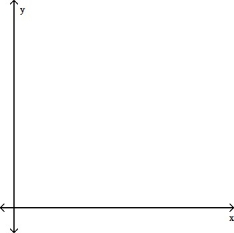
A)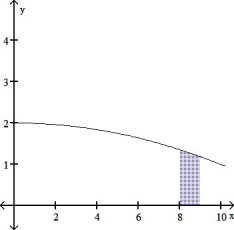
B)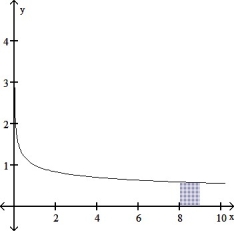
C)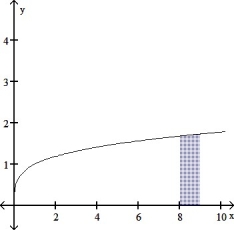
D)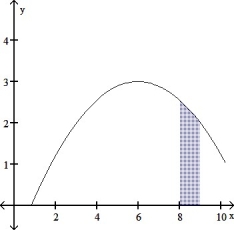
Calculate.
 dx
dx 
A)

B)

C)

D)

Calculate.

Unlock Deck
Unlock for access to all 135 flashcards in this deck.
Unlock Deck
k this deck
45
Use a Riemann sum to approximate the area under the graph of f(x) on the given interval. Use the right endpoints.
Enter just a real number to two decimal places.
f(x) = ; 0 ≤ x ≤ 2 , n = 4
; 0 ≤ x ≤ 2 , n = 4
Enter just a real number to two decimal places.
f(x) =
 ; 0 ≤ x ≤ 2 , n = 4
; 0 ≤ x ≤ 2 , n = 4
Unlock Deck
Unlock for access to all 135 flashcards in this deck.
Unlock Deck
k this deck
46
Draw the region whose area is given by the definite integral.  dx
dx 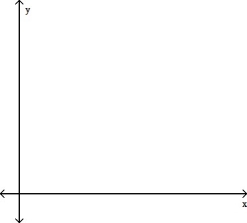
A)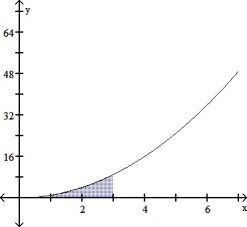
B)
C)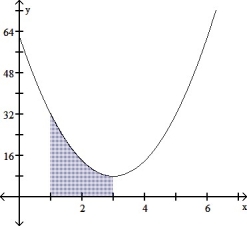
D)
 dx
dx 
A)

B)

C)

D)


Unlock Deck
Unlock for access to all 135 flashcards in this deck.
Unlock Deck
k this deck
47
Given the graph of the function y =  , set up the definite integral that gives the area of the shaded region.
, set up the definite integral that gives the area of the shaded region. 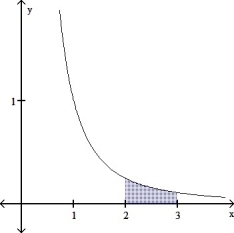
A) dx
dx
B) dx
dx
C) dx
dx
D) dx
dx
 , set up the definite integral that gives the area of the shaded region.
, set up the definite integral that gives the area of the shaded region. 
A)
 dx
dxB)
 dx
dxC)
 dx
dxD)
 dx
dx
Unlock Deck
Unlock for access to all 135 flashcards in this deck.
Unlock Deck
k this deck
48
Calculate.

A) -e + ln 3
B) ln 3
C) -ln 3
D)
E) none of these

A) -e + ln 3
B) ln 3
C) -ln 3
D)

E) none of these

Unlock Deck
Unlock for access to all 135 flashcards in this deck.
Unlock Deck
k this deck
49
Given f(x) =  + x +1 on the interval 0 ≤ x ≤ 4 and with n = 5, compute the Riemann sum (a) using the left endpoints; (b) using the right endpoints; and (c) using the midpoints of the subintervals. Enter your answer as just a, b, c all integers separated by commas.
+ x +1 on the interval 0 ≤ x ≤ 4 and with n = 5, compute the Riemann sum (a) using the left endpoints; (b) using the right endpoints; and (c) using the midpoints of the subintervals. Enter your answer as just a, b, c all integers separated by commas.
Enter the numbers in the order that answers (a), (b), (c) but do not label. Round to the nearest whole number.
 + x +1 on the interval 0 ≤ x ≤ 4 and with n = 5, compute the Riemann sum (a) using the left endpoints; (b) using the right endpoints; and (c) using the midpoints of the subintervals. Enter your answer as just a, b, c all integers separated by commas.
+ x +1 on the interval 0 ≤ x ≤ 4 and with n = 5, compute the Riemann sum (a) using the left endpoints; (b) using the right endpoints; and (c) using the midpoints of the subintervals. Enter your answer as just a, b, c all integers separated by commas.Enter the numbers in the order that answers (a), (b), (c) but do not label. Round to the nearest whole number.

Unlock Deck
Unlock for access to all 135 flashcards in this deck.
Unlock Deck
k this deck
50
Given the graph of the function y =  + 8, set up the definite integral that gives the area of the shaded region.
+ 8, set up the definite integral that gives the area of the shaded region. 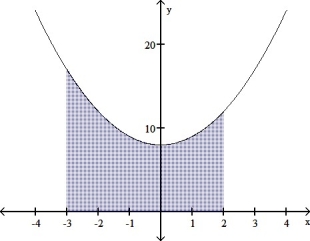
A) dx
dx
B) dx
dx
C) dx
dx
D) dx
dx
 + 8, set up the definite integral that gives the area of the shaded region.
+ 8, set up the definite integral that gives the area of the shaded region. 
A)
 dx
dxB)
 dx
dxC)
 dx
dxD)
 dx
dx
Unlock Deck
Unlock for access to all 135 flashcards in this deck.
Unlock Deck
k this deck
51
Given f(x) =  - 1 on the interval 1 ≤ x ≤ 5 and with n = 4, compute the Riemann sum (a) using the left endpoints; (b) using the right endpoints; and (c) using the midpoints of the subintervals. Enter your answer as just a, b, c all integers separated by commas.
- 1 on the interval 1 ≤ x ≤ 5 and with n = 4, compute the Riemann sum (a) using the left endpoints; (b) using the right endpoints; and (c) using the midpoints of the subintervals. Enter your answer as just a, b, c all integers separated by commas.
Enter the numbers in the order that answers (a), (b), (c) but do not label.
 - 1 on the interval 1 ≤ x ≤ 5 and with n = 4, compute the Riemann sum (a) using the left endpoints; (b) using the right endpoints; and (c) using the midpoints of the subintervals. Enter your answer as just a, b, c all integers separated by commas.
- 1 on the interval 1 ≤ x ≤ 5 and with n = 4, compute the Riemann sum (a) using the left endpoints; (b) using the right endpoints; and (c) using the midpoints of the subintervals. Enter your answer as just a, b, c all integers separated by commas.Enter the numbers in the order that answers (a), (b), (c) but do not label.

Unlock Deck
Unlock for access to all 135 flashcards in this deck.
Unlock Deck
k this deck
52
Given  set up a Riemann sum to approximate the area under the graph of f(x) on the given interval. Use the left endpoints. Is the following the correct sum?
set up a Riemann sum to approximate the area under the graph of f(x) on the given interval. Use the left endpoints. Is the following the correct sum?

 set up a Riemann sum to approximate the area under the graph of f(x) on the given interval. Use the left endpoints. Is the following the correct sum?
set up a Riemann sum to approximate the area under the graph of f(x) on the given interval. Use the left endpoints. Is the following the correct sum?

Unlock Deck
Unlock for access to all 135 flashcards in this deck.
Unlock Deck
k this deck
53
Draw the region whose area is given by the definite integral.  dx
dx 
A)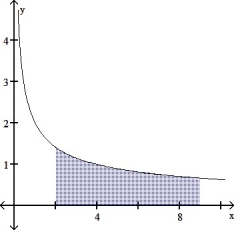
B)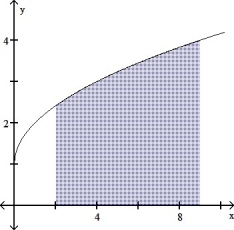
C)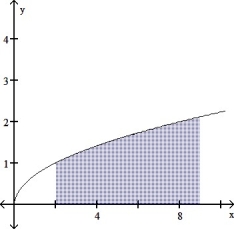
D)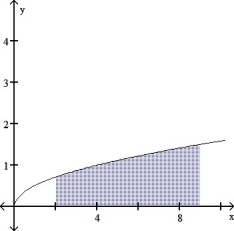
 dx
dx 
A)

B)

C)

D)


Unlock Deck
Unlock for access to all 135 flashcards in this deck.
Unlock Deck
k this deck
54
Given  set up a Riemann sum to approximate the area under the graph of f(x) on the given interval. Use the midpoints. Is the following the correct answer?
set up a Riemann sum to approximate the area under the graph of f(x) on the given interval. Use the midpoints. Is the following the correct answer?

 set up a Riemann sum to approximate the area under the graph of f(x) on the given interval. Use the midpoints. Is the following the correct answer?
set up a Riemann sum to approximate the area under the graph of f(x) on the given interval. Use the midpoints. Is the following the correct answer?

Unlock Deck
Unlock for access to all 135 flashcards in this deck.
Unlock Deck
k this deck
55
Use a Riemann sum to approximate the area under the graph of  Use the midpoints of the intervals.
Use the midpoints of the intervals.
Enter your answer as just a reduced fraction of form .
.
 Use the midpoints of the intervals.
Use the midpoints of the intervals.Enter your answer as just a reduced fraction of form
 .
.
Unlock Deck
Unlock for access to all 135 flashcards in this deck.
Unlock Deck
k this deck
56
Use a Riemann sum to approximate the area under the graph of  Use the left endpoints of the interval.
Use the left endpoints of the interval.
Enter an unlabeled answer.
 Use the left endpoints of the interval.
Use the left endpoints of the interval.Enter an unlabeled answer.

Unlock Deck
Unlock for access to all 135 flashcards in this deck.
Unlock Deck
k this deck
57
Use a Riemann sum to approximate the area under the graph of  Use the right endpoints.
Use the right endpoints.
Enter just a real number to two decimal places.
 Use the right endpoints.
Use the right endpoints.Enter just a real number to two decimal places.

Unlock Deck
Unlock for access to all 135 flashcards in this deck.
Unlock Deck
k this deck
58
Draw the region whose area is given by the definite integral.  dx
dx 
A)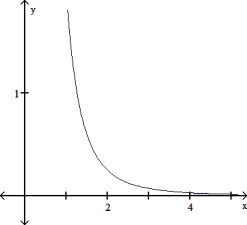
B)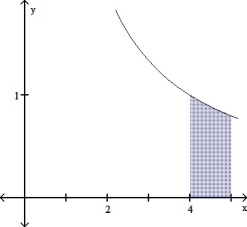
C)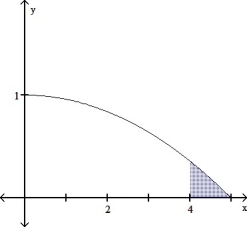
D)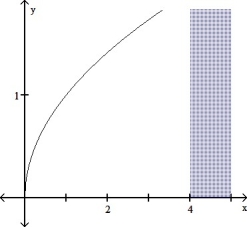
 dx
dx 
A)

B)

C)

D)


Unlock Deck
Unlock for access to all 135 flashcards in this deck.
Unlock Deck
k this deck
59
Calculate.

A)
 +
+ 
B) e +
e + 
C)
 - e -
- e - 
D)
E) none of these

A)

 +
+ 
B)
 e +
e + 
C)

 - e -
- e - 
D)

E) none of these

Unlock Deck
Unlock for access to all 135 flashcards in this deck.
Unlock Deck
k this deck
60
Calculate.

A)
B) -
C) -
D) -
E) none of these

A)

B) -

C) -

D) -

E) none of these

Unlock Deck
Unlock for access to all 135 flashcards in this deck.
Unlock Deck
k this deck
61
What is the area under the curve y = between x = 1 and x = 3?
A) ln 9
B) ln 3
C) 2 ln 3 - e
D) 2 ln 3 - 2
E) none of these
A) ln 9
B) ln 3
C) 2 ln 3 - e
D) 2 ln 3 - 2
E) none of these

Unlock Deck
Unlock for access to all 135 flashcards in this deck.
Unlock Deck
k this deck
62
 Enter your answer as a(b +
Enter your answer as a(b +  ) with any fractions in reduced form
) with any fractions in reduced form  .
.
Unlock Deck
Unlock for access to all 135 flashcards in this deck.
Unlock Deck
k this deck
63
 Enter a reduced fraction of form
Enter a reduced fraction of form  .
.
Unlock Deck
Unlock for access to all 135 flashcards in this deck.
Unlock Deck
k this deck
64
Determine the area under the curve y =  from x = 1 to x = e.
from x = 1 to x = e.
Enter just an integer.
 from x = 1 to x = e.
from x = 1 to x = e.Enter just an integer.

Unlock Deck
Unlock for access to all 135 flashcards in this deck.
Unlock Deck
k this deck
65
 Enter just an integer.
Enter just an integer.
Unlock Deck
Unlock for access to all 135 flashcards in this deck.
Unlock Deck
k this deck
66
 Enter your answer as a(
Enter your answer as a(  -
-  ) + d.
) + d.
Unlock Deck
Unlock for access to all 135 flashcards in this deck.
Unlock Deck
k this deck
67
What is the area under the curve y = + x from x = 1 to x = 2?
A)
B)
C)
D)
E) none of these
A)
B)
C)
D)
E) none of these

Unlock Deck
Unlock for access to all 135 flashcards in this deck.
Unlock Deck
k this deck
68
 Enter just an integer.
Enter just an integer.
Unlock Deck
Unlock for access to all 135 flashcards in this deck.
Unlock Deck
k this deck
69
 Enter just a reduced fraction of form
Enter just a reduced fraction of form  .
.
Unlock Deck
Unlock for access to all 135 flashcards in this deck.
Unlock Deck
k this deck
70
 Enter a reduced fraction of form
Enter a reduced fraction of form  .
.
Unlock Deck
Unlock for access to all 135 flashcards in this deck.
Unlock Deck
k this deck
71
 dx
dxEnter just a real number (no approximations).

Unlock Deck
Unlock for access to all 135 flashcards in this deck.
Unlock Deck
k this deck
72
Determine the area under the curve y = 4x + 4 from x = 2 to x = 3.
Enter an integer.
Enter an integer.

Unlock Deck
Unlock for access to all 135 flashcards in this deck.
Unlock Deck
k this deck
73
What is the area under the curve f(x) = 3 + 2x + 1 from x = - to x = - ?
A)
B)
C)
D) -
E) none of these
A)
B)
C)
D) -
E) none of these

Unlock Deck
Unlock for access to all 135 flashcards in this deck.
Unlock Deck
k this deck
74
 Enter your answer as a(
Enter your answer as a(  ±
±  ). Any fractions in reduced form
). Any fractions in reduced form  .
.
Unlock Deck
Unlock for access to all 135 flashcards in this deck.
Unlock Deck
k this deck
75
 Enter your answer as a reduced fraction of form
Enter your answer as a reduced fraction of form  .
.
Unlock Deck
Unlock for access to all 135 flashcards in this deck.
Unlock Deck
k this deck
76
What is the area under the curve y =  + 3
+ 3  between x = -
between x = -  and x =
and x =  ?
?
A) - e
- e
B) e +
C)
D)
E) none of these
 + 3
+ 3  between x = -
between x = -  and x =
and x =  ?
?A)
 - e
- eB) e +

C)

D)

E) none of these

Unlock Deck
Unlock for access to all 135 flashcards in this deck.
Unlock Deck
k this deck
77
What is the area under the curve y =  between x = 1 and x = 2?
between x = 1 and x = 2?
A) 2 - 2
- 2
B)
C) ln
D)
E) none of these
 between x = 1 and x = 2?
between x = 1 and x = 2?A) 2
 - 2
- 2B)

C) ln

D)

E) none of these

Unlock Deck
Unlock for access to all 135 flashcards in this deck.
Unlock Deck
k this deck
78
 Enter just an integer.
Enter just an integer.
Unlock Deck
Unlock for access to all 135 flashcards in this deck.
Unlock Deck
k this deck
79
Find the area under the curve y =  - 2x from x = -3 to x = -2.
- 2x from x = -3 to x = -2.
Enter a ± ln b using reduced fractions of form and integers.
and integers.
 - 2x from x = -3 to x = -2.
- 2x from x = -3 to x = -2.Enter a ± ln b using reduced fractions of form
 and integers.
and integers.
Unlock Deck
Unlock for access to all 135 flashcards in this deck.
Unlock Deck
k this deck
80
 Enter your answer as a(
Enter your answer as a(  -
-  ).
).
Unlock Deck
Unlock for access to all 135 flashcards in this deck.
Unlock Deck
k this deck



